

SuDS-related links
Keeping ahead
with SuDS
Attend SuDS training to keep ahead of the competition and to deliver innovative solutions in line with recognised good practice.
home > using SuDS > case studies > Lamb Drove
Lamb Drove is located within Cambourne, a new settlement 13km west of Cambridge (see Fig 1 and 2).
Fig 1: Location of Cambourne (click for link) |
Lamb Drove is a residential development of 35 affordable homes (developed and owned by Cambridge Housing Society) on a one hectare site. The aim of the Lamb Drove SuDS scheme was to showcase practical and innovative Sustainable Water Management Techniques (incorporating SuDS and property flood resilience and resistance) within new residential developments.
The project intended to demonstrate that SuDS are a viable and attractive alternative to more traditional forms of drainage and to deliver practical solutions for new housing areas.
A range of SuDS components were used to demonstrate different available techniques and the application of ‘management train’ from ‘prevention’ to ‘site control’ and ‘regional control’ components. The measures include:
Permeable Paving – The pavements within the residential roads is of permeable construction (see Fig 2 and 3). Gaps between the paving allow water to enter porous storage zones and to filter out pollutants.
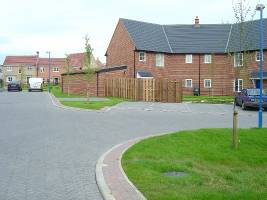 |
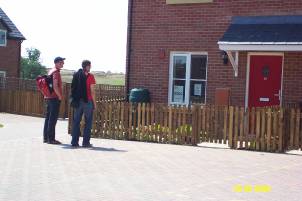 |
|---|---|
Fig 2: Permeable Paving |
Fig 3: Permeable Paving |
Green Roof - A small demonstration green sedum roof is included to reduce and treat runoff (see Fig 4 and 5).
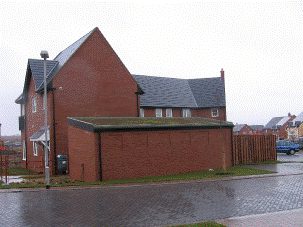 |
.jpg) |
|---|---|
Fig 4: Green roof on bike shed |
Fig 5: Green roof on bike shed |
Swales – Most of the excess water from the site will be fed into a series of shallow open channels, further slowing the flow of water and continuing the water treatment process (see Fig 6 and 7).
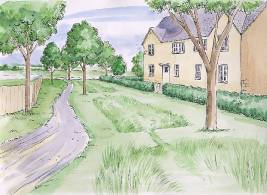 |
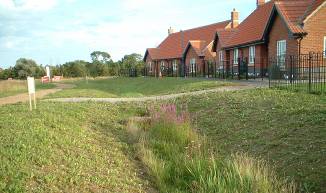 |
|---|---|
Fig 6: Swales (artist impression) |
Fig 7: Swales |
Detention Basins – Sculpted depressions in open spaces help to slow down the runoff rate and store water on a temporary short-term basis during extreme events(see fig 8 and 9).
|
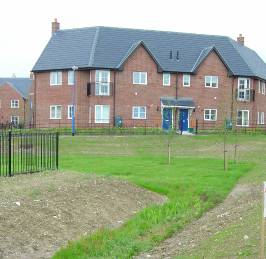 |
|---|---|
Fig 8: Detention basin |
Fig 9: Detention basin |
The concept of the management train was adopted for the site. The management train uses drainage components in series to improve the water quality and controls the quantity of runoff incrementally by reducing pollution, flow rates and volumes. It mimics as much as possible the natural pattern of drainage prior to development and uses a hierarchy of components within an integrated framework, to manage runoff as close as possible to the source.
Water management was considered from the point at which it falls on land and buildings to the point at which it leaves the site.
At Lamb Drove components and features have been kept simple, natural and visible. The aim is to control the runoff starting as close as possible to its source. The use of source control features within the housing development areas manages most pollution and deals with the day-to-day runoff storage requirements.
Roofwater is collected in water butts, for use in gardens, or flows directly to grass swales or under-drained swales. Rain falling on roads or paths will pass through the permeable block paving, where it is filtered and stored in the permeable layer of crushed rock below, or flows into under-drained swales where water is treated and conveyed. Water then travels downstream through a series of swales, detention basins and wetlands till it reaches a final retention pond. Here it is stored before being released to a local drainage ditch outside the development site.
When the capacity of source control components are exceeded the excess water is safely stored and treated in larger SuDS features integrated within public open space until the flood risk has passed. Such components also contribute to the provision of green space, green infrastructure, visual amenity and promoting wildlife. Throughout the site, blockage free and simple flow control structures as well as overland flow paths were provided to cater for more extreme flood events.
The driving force behind the project is the growing pressure for new housing in the UK. Cambridgeshire in particular is a key growth area under the government’s housing strategy, with up to 50,000 new houses planned to be built by 2016. It is also a relatively low-lying county where flooding in river valleys and urban watercourses is a major concern.
The project was part of a European funded programme (FLOWS), which featured 40 projects throughout Germany, the Netherlands, Norway, Sweden and the UK.
Once Lamb Drove had been chosen as the site for the project (in January 2004) it took just over two years to design and then install the system, with residents moving in during spring/early summer of 2006. Royal Haskoning were employed as drainage consultants and used their advice and guidance to help design the SuDS scheme at Lamb Drove.
Project time-scale constraints meant that the design principles and layout of the site were already set and the SuDS had to be built around it
Fig 10 illustrates the initial SuDS proposals developed for Lamb Drove. It clearly shows the range of SuDS measures (permeable paving, swales, detention basin etc) and demonstrates the principles of the management train and source control, detailed above.
The system and measures that were chosen were derived from the site topography and the pre-development drainage patterns, which ensure two key overland flood routes through the site.
.jpg) |
||
|---|---|---|
Fig 10: Initial SuDS proposal (courtesy Haskoning UK Ltd) Click on plan for detailed view |
In order to provide a 1:100 year return period volume with an extra 20% allowance for probable climate change, it became apparent that the peripheral public open space would be required to achieve a reasonable hierarchy of storage. Therefore recreational space in the LAP area within the site and in adjacent greenway and golf course were designed to contain SuDS.
The use of public open spaces, including adjacent, off-site open spaces, provides a viable solution to the problem of accommodating softer landscaped SuDS within housing developments.
In the early stages of the design, it was found that the full attenuation of runoff to a 1:100 year standard, with allowance for climate change, could be accommodated within the site boundary. However, this would have required the use of below ground storage techniques, which are costly and relatively more difficult to manage and maintain.
.jpg) |
||
|---|---|---|
Fig 11: Final design of SuDS system (courtesy Haskoning UK Ltd) Click on plan for detailed view |
The adopted final drainage strategy (see Fig 11) shows a number of key changes to the system. This includes the addition of a further detention basin in order to reduce the discharge rate from the site. Undertaking the changes from the initial proposals to the final design had resource implications. Therefore the lessons learnt from this project include the need for confirmation from all the key stakeholders and organisations early in the process and well before the final design if signed-off.
Amongst the many achievements of this project are the following:
Key lessons that have been learnt from undertaking this project include:
The key lessons from this project have been gathered together into a Best Practice Guide. This can be downloaded from the FLOWS website (www.flows.nu). A CD of the document is also available by contacting Cambridgeshire County Council.
Maintenance and Adoption - “Softer” measures (e.g. swales and detention basins) will be undertaken by Cambridge Housing Society (general site care) and the Cambridge Wildlife Trust (off-site care). This involves a monthly site visit to undertake grass cutting, litter picking and inlet/outlet inspections between March and November every year.
The permeable paving has not been adopted and maintained by Cambridgeshire County Council. The County Council and the developer have not yet reached the agreement of adopting the roads within Lamb Drove site and roads leading to the site, known as Section 38 agreement. Therefore the permeable pavements have been in operation without suction sweeping since the installation. Cambridge Housing Society have cleaned and manually swept the permeable pavements regularly.
Safety – Initially there were concerns from some parties due to the perceived notion that there would be lots of standing water within the system. However, education about the true nature of SuDS (e.g. that there would only be a small amount of water in them and that this would only be in heavy rainfall events), together with ROSPA (Royal Society for the Prevention of Accidents) undertaking a very successful and transparent safety audit, reassured stakeholders of the lack of risk.
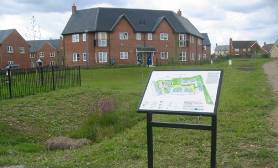 |
||
|---|---|---|
Fig 12: Display Board on site |
Education – In order that residents and wider community are aware of the SuDS measures at Lamb Drove they have all been presented with information on the system. In addition a site interpretation board has also been erected on site (see fig 12).
Performance data - Cambridgeshire County Council secured funding for the 3-year monitoring of the system (2008-2011) in order to demonstrate the long term impact of SuDS on both the quantity and quality of water leaving the site as well as environmental and social implications. Royal Haskoning was commissioned to undertake the monitoring. The Monitoring Report can be found from Cambridgeshire County Council web site.
The monitoring project aimed to assess and compare the performance of a range of SuDS components with that of pipe drainage system. It compared SuDS within Lamb Drove site and the pipe drainage within a local control site. The key findings of the monitoring project are:
Fig 13: Discharge of water in 13 and 14 December 2008 |
Fig 14: Comparisons of heavy metals |
Fig 15: Infiltration rates for permeable pavements at Lamb Drove |
For further information on the project see the Cambridgeshire County Council website
The information on the Lamb Grove project was
provided by:
Sass Pledger, Cambridgeshire County Council, Box No: CC1216, 2nd Floor A Wing, Castle Court, Shire Hall, Castle Hill, Cambridge, CB3 0AP
Fola Ogunyoye, Haskoning UK Ltd, Rightwell House, Bretton Centre, Peterborough, Cambridgeshire, PE3 8DW